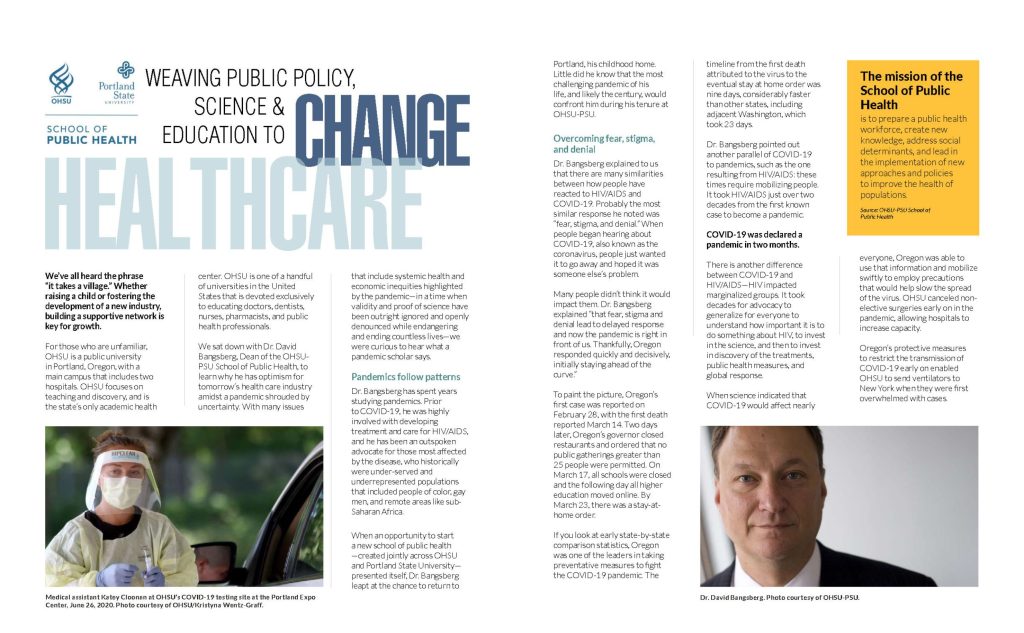Innovating For Good | OHSU
Weaving Public Policy, Science & Education to Change Healthcare
We’ve all heard the phrase “it takes a village.” Whether raising a child or fostering the development of a new industry, building a supportive network is key for growth.
For those who are unfamiliar, OHSU is a public university in Portland, Oregon, with a main campus that includes two hospitals. OHSU focuses on teaching and discovery, and is the state’s only academic health center. OHSU is one of a handful of universities in the United States that is devoted exclusively to educating doctors, dentists, nurses, pharmacists, and public health professionals.
We sat down with Dr. David Bangsberg, Dean of the OHSU-PSU School of Public Health, to learn why he has optimism for tomorrow’s health care industry amidst a pandemic shrouded by uncertainty. With many issues that include systemic health and economic inequities highlighted by the pandemic—in a time when validity and proof of science have been outright ignored and openly denounced while endangering and ending countless lives—we were curious to hear what a pandemic scholar says.
Pandemics follow patterns
Dr. Bangsberg has spent years studying pandemics. Prior to COVID-19, he was highly involved with developing treatment and care for HIV/AIDS, and he has been an outspoken advocate for those most affected by the disease, who historically were under-served and underrepresented populations that included people of color, gay men, and remote areas like sub-Saharan Africa.
When an opportunity to start a new school of public health —created jointly across OHSU and Portland State University— presented itself, Dr. Bangsberg leapt at the chance to return to Portland, his childhood home. Little did he know that the most challenging pandemic of his life, and likely the century, would confront him during his tenure at OHSU-PSU.
Overcoming fear, stigma, and denial
Dr. Bangsberg explained to us that there are many similarities between how people have reacted to HIV/AIDS and COVID-19. Probably the most similar response he noted was “fear, stigma, and denial.” When people began hearing about COVID-19, also known as the coronavirus, people just wanted it to go away and hoped it was someone else’s problem.
Many people didn’t think it would impact them. Dr. Bangsberg explained “that fear, stigma and denial lead to delayed response and now the pandemic is right in front of us. Thankfully, Oregon responded quickly and decisively, initially staying ahead of the curve.”
To paint the picture, Oregon’s first case was reported on February 28, 2020, with the first death reported March 14. Two days later, Oregon’s governor closed restaurants and ordered that no public gatherings greater than 25 people were permitted. On March 17, all schools were closed and the following day all higher education moved online. By March 23, there was a stay-at-home order.
If you look at early state-by-state comparison statistics, Oregon was one of the leaders in taking preventative measures to fight the COVID-19 pandemic. The timeline from the first death attributed to the virus to the eventual stay-at-home order was nine days, considerably faster than other states, including adjacent Washington, which took 23 days.
Dr. Bangsberg pointed out another parallel of COVID-19 to pandemics, such as the one resulting from HIV/AIDS: these times require mobilizing people. It took HIV/AIDS just over two decades from the first known case to become a pandemic.
COVID-19 was declared a pandemic in two months.
There is another difference between COVID-19 and HIV/AIDS—HIV impacted marginalized groups. It took decades for advocacy to generalize for everyone to understand how important it is to do something about HIV, to invest in the science, and then to invest in discovery of the treatments, public health measures, and global response.
When science indicated that COVID-19 would affect nearly everyone, Oregon was able to use that information and mobilize swiftly to employ precautions that would help slow the spread of the virus. OHSU canceled non-elective surgeries early on in the pandemic, allowing hospitals to increase capacity.
Oregon’s protective measures to restrict the transmission of COVID-19 early on enabled OHSU to send ventilators to New York when they were first overwhelmed with cases.
Being ahead of the curve allowed OHSU to donate 150 ventilators, which Dr. Bangsberg credits to following the data.
Identifying opportunity amidst a pandemic
Dr. Bangsberg believes that our greatest opportunity lies in investing upstream. To him, this means looking beyond the healthcare system, because the most successful preventative measures against COVID-19 didn’t happen in a hospital. Dr. Bangsberg credits Oregon’s success in fighting COVID-19 to physical distancing and wearing masks.
It’s his thinking that there is no way we can medically treat ourselves out of this crisis—there are no diagnostic tests that will magically stop COVID-19. There’s no procedure, and there’s no medication that will make it all go away.
“It is not a failure of healthcare delivery. It is a failure of policy that has put us in this crisis and the only way to get us out, is to reinvest.”
Where do we go from here?
Overcoming COVID-19 and the systemic barriers in place will require a group effort—a challenge that Dr. Bangsberg believes his students are ripe to overcome.
Dr. Bangsberg’s advice: “The most important thing we can do is outside the healthcare system. It’s how we interact as individuals, and as a neighborhood community, a city, and as a state. Are we adhering to physical distancing recommendations? Are we wearing our masks? Are we really doing what we can to prevent transmission?
“It will be hard to continue to do what is necessary to control transmission. Hopefully, we can control transmission with less invasive approaches, meaning moving from physical distance to contact tracing and isolation—but there’s no guarantee, and we’re experiencing a new surge of transmissions.
We still have important work to do.
“We’re all doing what is necessary to protect ourselves and our families, but also our communities. I know you didn’t sign up for this, but you are now a public health practitioner, so thank you.”
Sign up

